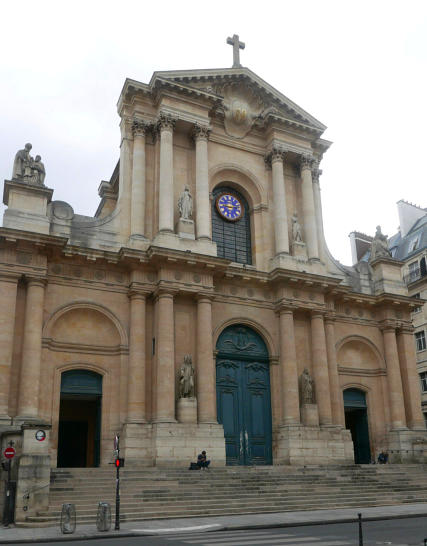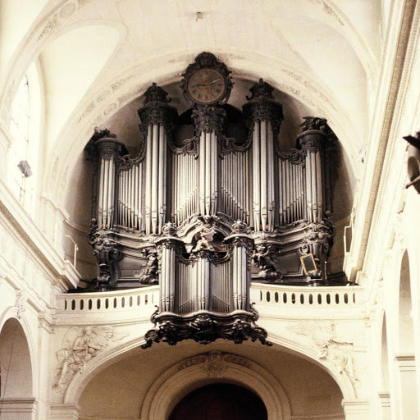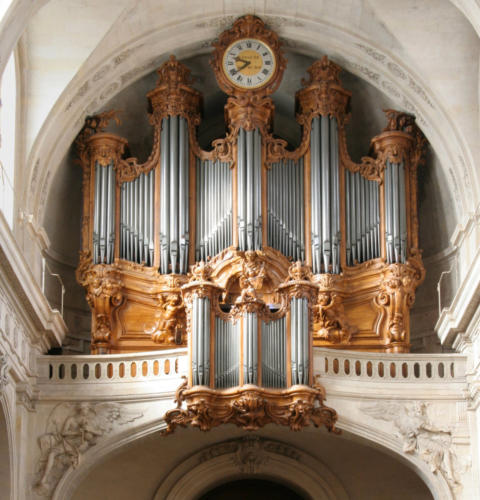


ORGANS OF PARIS © 2024 Vincent Hildebrandt HOME ALL ORGANS



The building of Saint-Roch started in 1653, but was
not finished until 1740. The baroque façade,
inspired by the Gesu-church of Rome, is decorated
with doric columns for the lower part (with statues
of St. Roch and St. Honoré) and corinthian columns
for the higher part (with statues of St. Geneviève
and Ste. Clothilde. The chancel was extended in
1709 with the circular Lady Chapel, again in 1717
with the Communion Chapel and finally with the
Calvary Chapel in 1754. This makes the church
unexpectedly lengthy. The church preserves a great
number of masterworks, paintings and sculptures,
partly derived from other churches destroyed
during the revolution.

E2
1750-1756
The organ was built by François-Henri Lesclop. The latter
died during the construction of the instrument and its
completion was entrusted to Louis-Alexandre Clicquot. Parts
of Etienne Enocq's old organ (1671) were incorporated.
1769-1770
François-Henri Clicquot carried out various works on the
windchests, and added reed stops and flutes. The organ then
had 50 stops on five manuals and pedalboard.
1805
Pierre Dallery repaired the instrument with pipes salvaged
from other Parisian instruments. In 1820, Pierre-François
Dallery completed this work by adding flute stops and reeds
and by expanding the pedal.
1842
The instrument was rebuilt by Aristide Cavaillé-Coll, who
reused much of the old pipework and most of the
windchests. He installed some new stops on the positive
and the great organ and increased the range of manuals to
54 notes. He built a new division of Récit and installed a
Barker machine on the great organ. The pedal is restored to
F for both flutes and reeds (25 notes). The organ then had 49
stops on 4 manuals and a pedalboard.
1859-1881
Other work was carried out by Cavaillé-Coll
1901
The range of the Pedal was extended by Charles Mutin from
25 to 30 notes.
1927/1948
A restoration was carried out in 1927 by Joseph
Gutschenritter Jr. The Swell is moved to the third keyboard
and the Bombarde to the fourth. The Récit receives a 16'
Quintaton, an 8' Gamba, and an 8' Voix Céleste in place of a
suppressed Clarinet and Voix Humaine. The action was
restored and combination pedals were added.
Between 1946 and 1948, the Swell was again augmented by
the same builder.
1994
A complete restoration was entrusted to Jean Renaud. The
restoration work aimed to restore the instrument to its
1858/81 configuration while preserving the range of the
pedal increased by Mutin. The harmonization was carried
out by Jean-Pierre Swiderski. The new parts are the chest of
the Récit (10 stops), the Viola da gamba, the Voix Céleste, the
Tierce and the complements of Plein jeu IX of the Positif, the
Voix Humaine of the Récit.
Most of the stops predate the Revolution, including all the reeds
of the GO, the Positive, and most of the reeds of the Pedal. This
organ is a beautiful synthesis between the classical French organ
of Clicquot and a romantic instrument of Cavaillé-Coll.


The organ before 1992
1756 - FH Lesclop/LA Clicquot (3)
1770 - FH Clicquot (2)
1805/1826 - Dallery (5)
1842/59/81 - Cavaille-Coll (3a)
1901 - Mutin (2)
1927/48 - Gutschenritter (5)
1992 - Renaud (5)
IV/53 - traction mécanique
composition
Organiste titulaire
Françoise Levéchin-Gangloff
Organistes célèbres ayant illustré l’instrument par le
passé: Claude-Bénigne Balbastre, Louis James Alfred
Lefébure-Wély, Pierre Cochereau (1945- 1955).
Concerts
Regularly.
Masses with organ
Saturday 6:30 PM on GO, Sunday 9:30 AM on OC
(forme extraordinaire) and 11:00 AM onGO
Videos
Françoise Levéchin-Gangloff.
All organs built before the revolution
Photo GO: Jeroen de Haan
The organs of Paris

ORGANS OF PARIS © 2024 Vincent Hildebrandt ALL ORGANS
E2
1750-1756
The organ was built by François-Henri Lesclop. The latter
died during the construction of the instrument and its
completion was entrusted to Louis-Alexandre Clicquot.
Parts of Etienne Enocq's old organ (1671) were
incorporated.
1769-1770
François-Henri Clicquot carried out various works on the
windchests, and added reed stops and flutes. The organ
then had 50 stops on five manuals and pedalboard.
1805
Pierre Dallery repaired the instrument with pipes salvaged
from other Parisian instruments. In 1820, Pierre-François
Dallery completed this work by adding flute stops and reeds
and by expanding the pedal.
1842
The instrument was rebuilt by Aristide Cavaillé-Coll, who
reused much of the old pipework and most of the
windchests. He installed some new stops on the positive
and the great organ and increased the range of manuals to
54 notes. He built a new division of Récit and installed a
Barker machine on the great organ. The pedal is restored to
F for both flutes and reeds (25 notes). The organ then had
49 stops on 4 manuals and a pedalboard.
1859-1881
Other work was carried out by Cavaillé-Coll
1901
The range of the Pedal was extended by Charles Mutin from
25 to 30 notes.
1927/1948
A restoration was carried out in 1927 by Joseph
Gutschenritter Jr. The Swell is moved to the third keyboard
and the Bombarde to the fourth. The Récit receives a 16'
Quintaton, an 8' Gamba, and an 8' Voix Céleste in place of a
suppressed Clarinet and Voix Humaine. The action was
restored and combination pedals were added.
Between 1946 and 1948, the Swell was again augmented by
the same builder.
1994
A complete restoration was entrusted to Jean Renaud. The
restoration work aimed to restore the instrument to its
1858/81 configuration while preserving the range of the
pedal increased by Mutin. The harmonization was carried
out by Jean-Pierre Swiderski. The new parts are the chest of
the Récit (10 stops), the Viola da gamba, the Voix Céleste,
the Tierce and the complements of Plein jeu IX of the Positif,
the Voix Humaine of the Récit.
Most of the stops predate the Revolution, including all the reeds
of the GO, the Positive, and most of the reeds of the Pedal. This
organ is a beautiful synthesis between the classical French
organ of Clicquot and a romantic instrument of Cavaillé-Coll.
1756 - FH Lesclop/LA Clicquot (3)
1770 - FH Clicquot (2)
1805/1826 - Dallery (5)
1842/59/81 - Cavaille-Coll (3a)
1901 - Mutin (2)
1927/48 - Gutschenritter (5)
1992 - Renaud (5)
IV/53 - traction mécanique
composition
Organiste titulaire
Françoise Levéchin-Gangloff
Organistes célèbres ayant illustré l’instrument par le passé:
Claude-Bénigne Balbastre, Louis James Alfred Lefébure-Wély,
Pierre Cochereau (1945- 1955).
Concerts
Regularly.
Masses with organ
Saturday 6:30 PM on GO, Sunday 9:30 AM on OC (forme
extraordinaire) and 11:00 AM onGO
Videos
Françoise Levéchin-Gangloff.
All organs built before the revolution
Photo GO: Jeroen de Haan






















